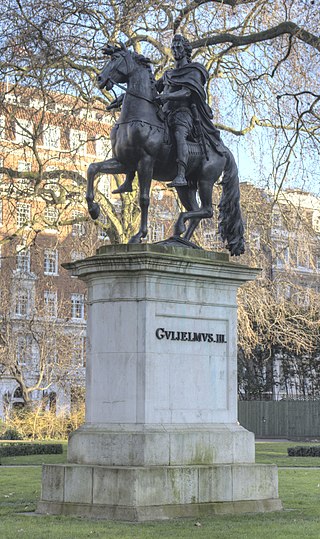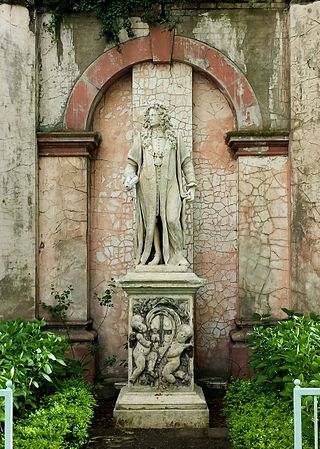Background
Guy the Gorilla was born at some point in 1946 in what was then French Cameroon. [2] Captured in 1947, he arrived at London Zoo on 5 November 1947 (Guy Fawkes Day) and was christened "Guy". He became one of the zoo's major attractions, famed for his gentle disposition. He died in 1978 of a heart attack while under general anaesthetic during an operation to extract a tooth. [3] His taxidermied remains are displayed at the entrance to the "Treasures" gallery in the central Hintze Hall at the Natural History Museum. [4] In addition to the sculpture at Crystal Palace Park, Guy is also commemorated by a bronze statue by William Timym, which was installed at London Zoo in 1982. [5]
In 1959, David Wynne was commissioned through London County Council's Patronage of the Arts Scheme to create a large animal sculpture, with the site to be determined later. Wynne had studied zoology at the University of Cambridge, and he chose the popular Guy the Gorilla as his subject. The work was completed in 1961, and the finished sculpture was installed in 1962 near the children's zoo at Crystal Palace Park. (The children's zoo closed around 1990.) The statue was subsequently credited with launching Wynne's artistic career. Never popular with the art establishment, Wynne's figurative sculptures, mainly of animals but also of such people of note as Thomas Beecham, John Gielgud and The Beatles, won affection from the public. Among his most controversial works was the centrepiece to the Queen Elizabeth Gate at Hyde Park Corner. Wynne died in 2014. [6]

Crystal Palace Park is a large park in south-east London, Grade II* listed on the Register of Historic Parks and Gardens. It was laid out in the 1850s as a pleasure ground, centred around the re-location of The Crystal Palace -- the largest glass building of the time -- from central London to this area on the border of Kent and Surrey; the suburb that grew around the park is known by the same name.

Guy the Gorilla (1946–1978) was a western lowland gorilla who was London Zoo's most famous resident and often profiled on children's TV shows and natural history productions. The exact day of Guy's birth was unknown, but his official birthday was set by the Zoo as May 30, and he received large numbers of cards each year.

The Crystal Palace Dinosaurs are a series of sculptures of dinosaurs and other extinct animals, inaccurate by modern standards, in the London borough of Bromley's Crystal Palace Park. Commissioned in 1852 to accompany the Crystal Palace after its move from the Great Exhibition in Hyde Park, they were unveiled in 1854 as the first dinosaur sculptures in the world. The models were designed and sculpted by Benjamin Waterhouse Hawkins under the scientific direction of Sir Richard Owen, representing the latest scientific knowledge at the time. The models, also known as the Geological Court or Dinosaur Court, were classed as Grade II listed buildings from 1973, extensively restored in 2002, and upgraded to Grade I listed in 2007.

The Machine Gun Corps Memorial, also known as The Boy David, is a memorial to the casualties of the Machine Gun Corps in the First World War. It is located on the north side of the traffic island at Hyde Park Corner in London, near the Wellington Arch, an Equestrian statue of the Duke of Wellington, the Royal Artillery Memorial, the New Zealand War Memorial, and the Australian War Memorial.
David Wynne was a British sculptor of figures, animals, and portraits.

The Messenger is a statue by the English sculptor David Wynne, OBE of a horse and rider. It was installed in the town centre of Sutton in Greater London, England in 1981.

A statue of Queen Anne is installed in the forecourt outside the west front of St Paul's Cathedral, in London, United Kingdom. It became a Grade II listed building in 1972.

Atalanta is a statue by the British sculptor Francis Derwent Wood. It shows a naked woman standing in a contrapposto position, glancing to her left, with her left hand by her side and right hand raised to her shoulder. The subject is Atalanta, a virgin huntress from Greek mythology; she may be preparing for the foot race she used as an obstacle to prevent suitors securing a marriage.

The equestrian statue of Ferdinand Foch stands in Lower Grosvenor Gardens, London. The sculptor was Georges Malissard and the statue is a replica of another raised in Cassel, France. Foch, appointed Supreme Commander of the Allied Forces on the Western Front in the Spring of 1918, was widely seen as the architect of Germany's ultimate defeat and surrender in November 1918. Among many other honours, he was made an honorary Field marshal in the British Army, the only French military commander to receive such a distinction. Following Foch's death in March 1929, a campaign was launched to erect a statue in London in his memory. The Foch Memorial Committee chose Malissard as the sculptor, who produced a replica of his 1928 statue of Foch at Cassel. The statue was unveiled by the Prince of Wales on 5 June 1930. Designated a Grade II listed structure in 1958, the statue's status was raised to Grade II* in 2016.

The equestrian statue of William III by John Bacon Junior stands in St James's Square in central London. It is modelled on an earlier statue of the king by John Michael Rysbrack in Queen Square, Bristol. Funding for the London statue was provided in the will of Samuel Travers, M.P., dated 1724, but nothing was done to progress the plan for a further seventy years. A design for the monument was drawn up in 1794 by Bacon's father, John Bacon Senior, but this was not executed and the commission passed to Bacon Jr., under whose direction the statue was finally erected in 1808. The statue is a Grade I listed structure.

The statue of Charles II stands in the Figure, or Middle, Court of the Royal Hospital, Chelsea, London. The sculptor was Grinling Gibbons, and the statue was executed around 1680–1682. The king founded the Royal Hospital in 1682 as a home for retired army veterans. The statue is a Grade I listed structure.

The statue of Robert Clayton stands at the entrance to the North Wing of St Thomas' Hospital, Lambeth, London. The sculptor was Grinling Gibbons, and the statue was executed around 1700–1714. Sir Robert was a banker, politician and Lord Mayor of London. As President of St Thomas', he was responsible for the complete rebuilding of the hospital, and associated church in the late 17th century. The statue was designated a Grade I listed structure in 1979.

The statue of Charles James Fox stands at the north end of Bloomsbury Square in the London borough of Camden. Erected in 1816, the sculptor was Richard Westmacott. It commemorates the Whig politician who died in 1806. Fox is shown in the garb of a Roman senator. The statue is a Grade II* listed structure.

The Memorial to Dr Barnardo by George Frampton, at Barkingside in the London Borough of Redbridge, commemorates the founder of the Barnardo's children's charity. Born in Dublin into a Sephardic Jewish family, Thomas John Barnardo moved to the East End of London in 1866 where he established a chain of orphanages that developed into the Barnardo's charity. He died in 1905 and, in a move unusual for the time, was cremated; his ashes were interred in front of Cairn's House, the original building of his Barkingside children's village. In 1908, a memorial was raised on the site, the sculpture being undertaken by George Frampton, who worked without a fee. The memorial was designated a Grade II listed structure in 1979 and upgraded to II* in 2010.

Twickenham War Memorial, in Radnor Gardens, Twickenham, London, commemorates the men of the district of Twickenham who died in the First World War. After 1945, the memorial was updated to recognise casualties from the Second World War. The memorial was commissioned by Twickenham Urban District Council in 1921. It was designed by the sculptor Mortimer Brown, and is Brown's only significant public work. The memorial is unusual for its representation of a jubilant soldier returning home. It became a Grade II* listed structure in 2017.

The Memorial to Arthur Sullivan by William Goscombe John stands in Victoria Embankment Gardens in the centre of London. It was designated a Grade II listed structure in 1958.

A bronze statue of Robert Stephenson by Carlo Marochetti usually stands on a red granite plinth in the forecourt of Euston railway station in London, England. Erected in 1871, it is one of few surviving elements of the original station after it was redeveloped in the 1960s, and it became a Grade II listed building in 1974. It was temporarily removed in 2020 to allow the station to be remodelled to accommodate the new High Speed 2 (HS2) railway line.

An equestrian statue of Charles II trampling Cromwell stands near Newby Hall in North Yorkshire, England. It was previously sited at Gautby Hall in Lincolnshire, and was originally installed at the Stocks Market in the City of London. It is a Grade II listed building.

The Gladstone Memorial on the Strand, London is a bronze sculpture of the British statesman, created by Hamo Thornycroft between 1899-1905. The statue was erected as the national memorial to Gladstone and shows him in the robes of the Chancellor of the Exchequer. The figure stands on a plinth surrounded by allegorical figures depicting four of the Virtues, Courage, Brotherhood, Education and Aspiration. The memorial is a Grade II listed structure.


















